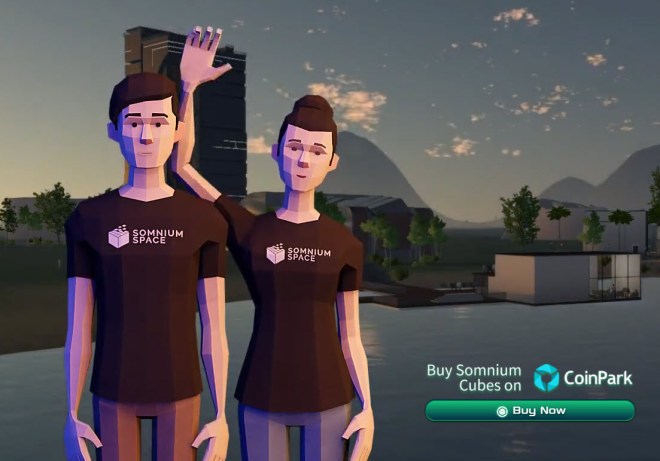Early this morning, I was finally able to stroll around version 2.0 of the blockchain-based social VR platform, Somnium Space. The company has dropped a new, 1-1/2 minute trailer to promote the official launch of version 2.0:
I’m going to break down my first impressions into several sections.
Downloading Version 2.0
You can download the client from Steam or directly from their website. The installation process involves downloading and installing a small launcher program, which then downloads the full client, which is about 3.5GB in size.
As I reported yesterday, I encountered some problems downloading the full client from the Somnium Space servers. The server went down several times yesterday and last night, and had to be reset. Also, I was getting a download speed of only 1 MB per second on average:

I ran Speedtest to check my bandwidth while downloading the client, and as you can see, I had plenty of bandwidth to spare, so the problem lay with their servers, and not with my computer:

Several times the launcher program hung, and had to be restarted. I’m not sure if the problems were because so many people were trying to download the client on the first day, but it was rather annoying. I landed up spending from about noon yesterday until 3:00 a.m. this morning, off and on, trying to download version 2.0 of the client! Let’s hope that these were just opening day technical glitches.
Two Clients: VR and PC
Once completely downloaded, you use the launcher to start the program, which automatically checks for any software updates before taking you to the main screen. There are actually two clients: one VR (3D) and one flatscreen (PC/2D), and they are used for different purposes.

The flatscreen client is used to select your avatar and to build on land you have purchased (like Second Life, there is an extensive array of in-world building tools; see the video at the end of this blogpost).
The VR client is the main Somnium Space client, which you use to navigate the social VR platform. Somnium Space works with any PCVR headset (i.e. a VR headset that requires a higher-end computer with a good graphics card), including Oculus Rift and HTC Vive. It also works with Oculus Quest and Oculus Link.
Please note that there will not be a desktop (non-VR) client for Somnium Space until next week at the earliest. The company decided to focus on VR users first. If you don’t have PCVR, then you are out of luck at present.
The Version 2.0 Avatars
One of the biggest changes in version 2.0 of Somnium Space are the avatars, which are now complete, full-body avatars instead of the head-and-shoulders ones in version 2.0.

The starting set of default avatars is stylized and functional, but they are rather blocky-looking, and they are certainly not going to win any beauty contests.
You actually select your avatar using the flatscreen (2D) version of the client, instead of the VR (3D) version:

At present, you cannot change any aspect of these avatars, such as the hairstyle or colour, or the clothing. Artur Sychov, the CEO of Somnium Space, tells me that they are planning to release UnitySDK next week so that people can build their own custom avatars, so I am looking forward to seeing what people create!
A Wonderful Sense of Space

Somnium Space is among the first social VR platforms where you really do get a sense of the vast scale of the landscape. The platform is designed to be one contiguous landmass, instead of individual worlds. I have been told that there will be charge for teleporting (or perhaps, teleporting after watching an advertisement), to encourage users to walk around. And yes, you can hike all the way into the misty mountains you can see in the horizon!
The in-world camera tool on the user interface tablet isn’t functional yet, but I was able to take a few screenshots using SnagIt while in my Oculus Rift this morning. There is a pleasant central town that boasts a lighthouse, a seaside café, a shopping mall, a bowling alley, and a planetarium, among other attractions.

Dotted here and there on the gently undulating landscape outside this town are the first buildings, including some interesting and innovative constructions. The whole world has a sense of a festival being set up.

While the central town and the landscape remain in 3D, the user-built buildings load in stages as you approach them, in a sensible effort to lessen the load on the client.
Final Thoughts and Impressions
Artur Sychov and his team at Somnium Space are to be commended for pushing the envelope as to what is possible in a blockchain-based social VR platform.
While Decentraland and Cryptovoxels are currently more popular in terms of transaction volume on OpenSea, the former doesn’t support virtual reality at all, and the latter is restricted to voxel-based building. I suspect that once people begin to compare all three platforms feature-for-feature, they will begin to see the benefits of the more realistic-looking, more attractive in-world experience offered by Somnium Space, and they will choose to invest.
Opening-day glitches aside, this is an extremely promising start, and I look forward to seeing how Somnium Space develops over time!
If you want more information about Somnium Space, you can visit their website, or follow them on social media: Facebook, Instagram, Telegram, Twitter, and YouTube. You can also join their official Discord server.







